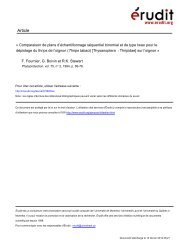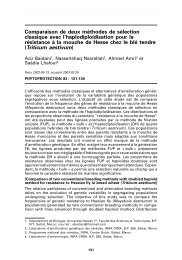Survey of plant-parasitic and entomopathogenic nematodes in ...
Survey of plant-parasitic and entomopathogenic nematodes in ...
Survey of plant-parasitic and entomopathogenic nematodes in ...
Create successful ePaper yourself
Turn your PDF publications into a flip-book with our unique Google optimized e-Paper software.
BÉLAIR ET AL. : NEMATODES IN VINEYARDS<strong>Survey</strong> <strong>of</strong> <strong>plant</strong>-<strong>parasitic</strong> <strong>and</strong> <strong>entomopathogenic</strong><strong>nematodes</strong> <strong>in</strong> v<strong>in</strong>eyards <strong>of</strong> QuebecGuy Bélair 1 , Nathalie Dauph<strong>in</strong>ais 1 , Yvon Fournier 1 , <strong>and</strong> HervéMauléon 2Received 2001-01-19; accepted 2001-06-26PHYTOPROTECTION 82 : 49-55A survey <strong>of</strong> <strong>plant</strong>-<strong>parasitic</strong> <strong>and</strong> <strong>entomopathogenic</strong> <strong>nematodes</strong> associatedwith v<strong>in</strong>eyards was undertaken <strong>in</strong> the Estrie <strong>and</strong> Montérégie regions, thetwo major grapev<strong>in</strong>e-produc<strong>in</strong>g areas <strong>in</strong> Quebec. Soil samples from 13sampled v<strong>in</strong>eyards were analyzed for the occurrence <strong>of</strong> <strong>plant</strong>-<strong>parasitic</strong> <strong>and</strong><strong>entomopathogenic</strong> <strong>nematodes</strong>. Six genera <strong>of</strong> <strong>plant</strong>-<strong>parasitic</strong> <strong>nematodes</strong>were observed. The most commonly encountered <strong>plant</strong>-<strong>parasitic</strong> nematodegenera were Pratylenchus <strong>and</strong> Paratylenchus, both occurr<strong>in</strong>g <strong>in</strong> 85% <strong>of</strong>sampled v<strong>in</strong>eyards. No Xiph<strong>in</strong>ema sp. were observed <strong>in</strong> surveyed v<strong>in</strong>eyards.Entomopathogenic <strong>nematodes</strong> were recovered from 85% <strong>of</strong> the samples.Heterorhabditid <strong>and</strong> ste<strong>in</strong>ernematid <strong>nematodes</strong> were isolated from one <strong>and</strong>11 v<strong>in</strong>eyards respectively. Ste<strong>in</strong>ernematid isolates were identified asSte<strong>in</strong>ernema carpocapsae.[Inventaire des nématodes phytoparasites et entomopathogènes dans desvignobles du Québec]Un <strong>in</strong>ventaire des nématodes phytoparasites et entomopathogènes présentsdans des vignobles du Québec a été réalisé dans les régions de l’Estrie etde la Montérégie, les deux pr<strong>in</strong>cipales régions productrices de vignes. Deséchantillons de sol provenant de 13 vignobles ont été analysés pour laprésence de nématodes phytoparasites et entomopathogènes. Six genresde nématodes phytoparasites ont été observés. Les genres les plusfréquemment retrouvés étaient Pratylenchus et Paratylenchus, lesquels ontété observés dans 85 % des échantillons de sol. Aucun spécimen du genreXiph<strong>in</strong>ema n’a été retrouvé dans les vignobles. La présence de nématodesentomopathogènes fut notée dans 85 % des vignobles échantillonnés. Desnématodes entomopathogènes de la famille des Ste<strong>in</strong>ernematidae ont étéobservés dans 11 vignobles et des Heterorhabditidae dans un seul vignoble.Tous les isolats de Ste<strong>in</strong>ermatidae ont été identifiés comme étant del’espèce Ste<strong>in</strong>ernema carpocapsae.1. Agriculture <strong>and</strong> Agri-Food Canada, 430 Gou<strong>in</strong> Blvd., Sa<strong>in</strong>t-Jean-sur-Richelieu (Quebec),Canada J3B 3E6; e-mail : belairg@em.agr.ca2. Institut National de la Recherche Agronomique – Centre Antilles-Guyane, 97170 PetitBourg, Guadeloupe, France49
INTRODUCTIONS<strong>in</strong>ce the first commercial v<strong>in</strong>eyard was<strong>plant</strong>ed <strong>in</strong> Quebec <strong>in</strong> 1976, the totalw<strong>in</strong>e grape (Vitis v<strong>in</strong>ifera L.) area has<strong>in</strong>creased to more than 125 ha support<strong>in</strong>gapproximately 30 active enterprises(Dubois <strong>and</strong> Deshaies 1997). Most v<strong>in</strong>eyardsare located <strong>in</strong> the Estrie <strong>and</strong>Montérégie regions. An earlier nematologicalsurvey conducted <strong>in</strong> these sameagricultural regions reported several<strong>plant</strong>-<strong>parasitic</strong> <strong>nematodes</strong> <strong>of</strong> economicimportance (Vra<strong>in</strong> <strong>and</strong> Rousselle 1980).Among these, Xiph<strong>in</strong>ema spp., Pratylenchusspp. <strong>and</strong> Meloidogyne spp.were frequently encountered <strong>and</strong> havebeen shown to cause major economiclosses to w<strong>in</strong>e grape <strong>in</strong> other countries(McElroy 1972). In Quebec, the occurrence<strong>of</strong> <strong>plant</strong>-<strong>parasitic</strong> <strong>and</strong> <strong>entomopathogenic</strong><strong>nematodes</strong> <strong>in</strong> v<strong>in</strong>eyardshas not been <strong>in</strong>vestigated.Lately, major growers <strong>in</strong> this <strong>in</strong>dustryhave jo<strong>in</strong>ed an <strong>in</strong>tegrated pest managementprogram to reduce their reliance<strong>and</strong> use <strong>of</strong> pesticides <strong>and</strong> thus promote<strong>and</strong> <strong>in</strong>crease populations <strong>of</strong> predatoryentom<strong>of</strong>auna on <strong>in</strong>sect pests. In thisregard, the presence <strong>of</strong> <strong>entomopathogenic</strong><strong>nematodes</strong>, such as ste<strong>in</strong>ernematids<strong>and</strong> heterorhabditids (which areknown to kill a large number <strong>of</strong> <strong>in</strong>sectlarvae), could be useful <strong>in</strong> ma<strong>in</strong>ta<strong>in</strong><strong>in</strong>gpressure on soil <strong>in</strong>sect pests (Bedd<strong>in</strong>g<strong>and</strong> Miller 1981; Simons 1981).Our objective was to survey the majorv<strong>in</strong>eyards for the occurrence <strong>of</strong> both<strong>plant</strong>-<strong>parasitic</strong> <strong>and</strong> <strong>entomopathogenic</strong><strong>nematodes</strong> associated with grape v<strong>in</strong>es<strong>in</strong> Quebec.MATERIALS AND METHODSFrom June to August 1998, a survey <strong>of</strong>13 v<strong>in</strong>eyards <strong>in</strong> the Estrie <strong>and</strong>Montérégie regions was undertaken toassess the distribution <strong>of</strong> <strong>plant</strong>-<strong>parasitic</strong><strong>and</strong> <strong>entomopathogenic</strong> <strong>nematodes</strong><strong>in</strong> v<strong>in</strong>eyards. The 13 v<strong>in</strong>eyards surveyedrepresent 42% <strong>of</strong> Quebec v<strong>in</strong>eyards <strong>and</strong>59% <strong>of</strong> v<strong>in</strong>eyards located <strong>in</strong> the Estrie<strong>and</strong> Montérégie (Table 1). V<strong>in</strong>eyardswere between 13 <strong>and</strong> 18 yr old, <strong>and</strong>v<strong>in</strong>eyard size ranged from 1.4 to 11.3 ha.A total <strong>of</strong> 142 soil samples was collectedfrom the 13 v<strong>in</strong>eyards. The number<strong>of</strong> soil samples for each v<strong>in</strong>eyardranged from 4 to 17 with approximately1.5 kg soil collected for each sample toa depth <strong>of</strong> 0-20 cm. For each v<strong>in</strong>eyard,soil samples were r<strong>and</strong>omly collectedbeside the grapev<strong>in</strong>e roots with a h<strong>and</strong>trowel (5-cm-diam x 20-cm deep). Soilsamples were placed <strong>in</strong> plastic bags <strong>and</strong>stored at 4°C until the nematode extractionor bait<strong>in</strong>g.Plant-<strong>parasitic</strong> nematode numberswere estimated by process<strong>in</strong>g one subsample<strong>of</strong> 100 cm 3 by the modifiedBaermann pan method (TownshendTable 1. Description <strong>of</strong> the v<strong>in</strong>eyards sampled <strong>in</strong> the surveyPHYTOPROTECTION 82 (2) 2001Locality Sampl<strong>in</strong>g date V<strong>in</strong>eyard’s name Production area (ha)Dunham #1 1998-06-25 Les Côtes d’Ardoises 8.0Dunham #2 1998-06-25 Les Arpents de Neige 9.9Dunham #3 1998-06-25 L’Orpailleur 11.3Grantham 1998-07-29 L’Aurore Boréale 4.0Iberville 1998-06-23 Dietrich-Jooss 4.5Lacolle 1998-06-23 Angell 5.0Magog 1998-06-30 Le Cep d’Argent 11.0Napierville #1 1998-06-23 Morou 1.8Napierville #2 1998-08-04 Leroyer/St-Pierre 5.0Rock-Forest 1998-06-30 Sous les Charmilles 1.4Sabrevois 1998-06-23 Des P<strong>in</strong>s 2.2Sa<strong>in</strong>t-Grégoire 1998-06-23 Clos de la Montagne 2.8Stanbridge 1998-06-25 Doma<strong>in</strong>e de l’Ardennais 2.050
BÉLAIR ET AL. : NEMATODES IN VINEYARDS1963). Plant-<strong>parasitic</strong> <strong>nematodes</strong> werecounted by us<strong>in</strong>g a stereo-microscope<strong>and</strong> identified to the genus.Entomopathogenic <strong>nematodes</strong> wereisolated from soil by us<strong>in</strong>g wax mothlarvae (Galleria melonella L.) [Lepidoptera: Galleriidae] as bait accord<strong>in</strong>gto the method <strong>of</strong> Bedd<strong>in</strong>g <strong>and</strong> Akhurst(1975). Soil samples (400 g) were placed<strong>in</strong> 500-ml plastic conta<strong>in</strong>ers covered witha lid, <strong>and</strong> five Galleria larvae were added.Each plastic conta<strong>in</strong>er was <strong>in</strong>cubatedat room temperature (22°C) for 5d. If no larvae died after 5 d, we consideredthat <strong>entomopathogenic</strong> <strong>nematodes</strong>were absent from that sample.Dead G. melonella larvae were removed<strong>and</strong> placed on a moistened filter paper(Whatman No. 2) <strong>in</strong> a 90-mm Petri dishat room temperature (22°C). Each Petridish was checked every 2 d for <strong>nematodes</strong>.After 10 d, all decayed <strong>and</strong>/orfilthy odoured cadavers were discarded.Emerg<strong>in</strong>g <strong>nematodes</strong> from wellpreserved,odorless cadavers <strong>and</strong> withapparent synchronous larval stage wereconcentrated <strong>and</strong> checked for positivekill<strong>in</strong>g <strong>of</strong> healthy Galleria larvae <strong>in</strong> aPetri dish bioassay. Newly emerg<strong>in</strong>g<strong>nematodes</strong> from larvae were recordedas Ste<strong>in</strong>ermatidae, <strong>and</strong> those emerg<strong>in</strong>gfrom reddish cadavers were classifiedas Heterorhabditidae.RESULTS AND DISCUSSIONPlant-<strong>parasitic</strong> <strong>nematodes</strong> isolated dur<strong>in</strong>gthis survey are grouped <strong>in</strong>to twomajor biological classes : endoparasites<strong>and</strong> ectoparasites. The endo<strong>parasitic</strong>species are generally the most pathogenicspecies to cultivated <strong>plant</strong>s (McElroy1972). Meloidogyne hapla Chitwood<strong>and</strong> Pratylenchus spp. were the twoendoparasites, <strong>and</strong> Criconemoides spp.,Gracilacus spp., Helicotylenchus spp.,<strong>and</strong> Paratylenchus spp. were the fourectoparasites recovered from the surveyedv<strong>in</strong>eyards (Table 2).Pratylenchus was the most commonlyencountered endo<strong>parasitic</strong> genus, present<strong>in</strong> 85% <strong>of</strong> surveyed v<strong>in</strong>eyards. The northernroot-knot, Meloidogyne hapla, wasobserved <strong>in</strong> 23% <strong>of</strong> soil samples (Table2). The results concern<strong>in</strong>g theroot-lesion nematode are <strong>in</strong> agreementwith many <strong>plant</strong>-<strong>parasitic</strong> nematode surveysconducted <strong>in</strong> the prov<strong>in</strong>ce <strong>of</strong> Quebec,which have shown that <strong>in</strong> mostagricultural regions, Pratylenchus wasthe most dom<strong>in</strong>ant genus (Meloche etal. 1980; Santerre <strong>and</strong> Lévesque 1982;Vra<strong>in</strong> <strong>and</strong> Dupré 1982; Vra<strong>in</strong> <strong>and</strong> Rousselle1980; Willis et al. 1976).Among the six genera <strong>of</strong> <strong>plant</strong>-<strong>parasitic</strong><strong>nematodes</strong>, Meloidogyne haplawas the only species found <strong>in</strong> this surveythat has been reported to causeeconomic loss <strong>in</strong> other grape-grow<strong>in</strong>gareas <strong>of</strong> the world (Bird <strong>and</strong> Ramsdell1985; P<strong>in</strong>kerton et al. 1999; Ramsdell etal. 1996). Fortunately, Meloidogynehapla was limited to a small number <strong>of</strong>v<strong>in</strong>eyards <strong>in</strong> Quebec <strong>and</strong> is not knownto promote any serious disease on thiscrop.When grapev<strong>in</strong>es are <strong>plant</strong>ed <strong>in</strong> soil<strong>in</strong>fested with high population densities<strong>of</strong> <strong>plant</strong>-<strong>parasitic</strong> <strong>nematodes</strong>, their establishment<strong>and</strong> growth will most likelybe reduced (McKenry 1992). In Quebecv<strong>in</strong>eyards found <strong>in</strong>fested with Meloidogynehapla, it is unlikely that establishment<strong>and</strong> productivity <strong>of</strong> grapev<strong>in</strong>e<strong>plant</strong>s will suffer, based on the lowpopulation densites (
PHYTOPROTECTION 82 (2) 2001Table 2. Frequency <strong>of</strong> occurence <strong>and</strong> density (m<strong>in</strong>imum <strong>and</strong> maximum ) <strong>of</strong> <strong>plant</strong>-<strong>parasitic</strong> <strong>nematodes</strong> <strong>in</strong> soil samples collected <strong>in</strong> 13 v<strong>in</strong>eyards <strong>in</strong>QuebecEndo<strong>parasitic</strong> <strong>nematodes</strong> Ecto<strong>parasitic</strong> <strong>nematodes</strong>Locality no. a Meloidogyne hapla Pratylenchus spp. Criconemoides spp. Gracilacus spp. Helicotylenchus spp. Paratylenchus spp.Dunham #1 12 - 33 (2-36) 8 (1-1) 58 (4-30) - 8 (4-4)Dunham #2 4 - 75 (4-35) - 50 (2-4) - 75 (4-25)Dunham #3 12 - 50 (1-8) 25 (2-9) 17 (2-2) 17 (2-6) 58 (2-110)Grantham 12 33 b (22-174) c 33 (2-8) - 8 (1-1) 25 (2-20) 58 (4-42)Iberville 15 - 47 (2-150) - - - 47 (2-220)Lacolle 8 13 (25-25) 63 (4-35) - - - 75 (2-340)Magog 17 - 44 (2-20) - - - 94 (4-440)Napierville #1 11 - 18 (2-2) 9 (3-3) 82 (4-50) - 55 (2-36)Napierville #2 15 - - - 7 (5-5) - 7 (5-5)Rock-Forest 10 10 (1-1) 80 (1-35) 10 (1-1) - 10 (2-2) 30 (1-9)Sabrevois 12 - 67 (2-25) - 25 (1-2) 8 (4-4) 25 (2-35)Sa<strong>in</strong>t-Grégoire 7 - 14 (2-2) - - - -Stanbridge 7 - - 14 (2-2) - - -Occurrence <strong>in</strong> soilsamples (%) 4 39 6 18 5 42Occurrence <strong>in</strong>v<strong>in</strong>eyards (%) 23 85 38 54 31 85ano. = number <strong>of</strong> soil samples <strong>in</strong> each v<strong>in</strong>eyard (total no. = 142).bFrequency = percentage <strong>of</strong> occurrence <strong>in</strong> soil samples.cM<strong>in</strong>imum <strong>and</strong> maximum numbers <strong>of</strong> <strong>nematodes</strong> per 100 cm 3 <strong>of</strong> soil.52
BÉLAIR ET AL. : NEMATODES IN VINEYARDSv<strong>in</strong>eyards. This was a surprise, s<strong>in</strong>cesome v<strong>in</strong>eyards <strong>in</strong> the Estrie region were<strong>plant</strong>ed <strong>in</strong> old apple orchards found tobe <strong>in</strong>fested with Xiph<strong>in</strong>ema spp. <strong>in</strong> anearlier survey (Vra<strong>in</strong> <strong>and</strong> Rousselle1980). In all major grape-grow<strong>in</strong>g regions<strong>of</strong> the world, Xiph<strong>in</strong>ema spp. aregenerally present <strong>and</strong> some specieshave caused important economic damageas primary vectors <strong>of</strong> virulent <strong>plant</strong>viruses, such as the fanleaf virus <strong>of</strong>grape (Raski <strong>and</strong> Krusberg 1984) <strong>and</strong>the tomato r<strong>in</strong>gspot virus (Allen et al.1988).Entomopathogenic <strong>nematodes</strong> wererecovered from 85% <strong>of</strong> the surveyedv<strong>in</strong>eyards (Table 3). Ste<strong>in</strong>ernematidswere found <strong>in</strong> 11 v<strong>in</strong>eyards <strong>and</strong> heterorhabditids<strong>in</strong> one v<strong>in</strong>eyard (Table 3).The relative prevalence <strong>of</strong> the Ste<strong>in</strong>ernematidae<strong>in</strong> comparison with theHeterorhabditidae agree with earliersurveys carried out by Mracek <strong>and</strong>Webster (1993) <strong>and</strong> Yoshida et al. (1998)<strong>in</strong> which they reported that ste<strong>in</strong>ernematidswere more common than heterorhabditids.It is easier to f<strong>in</strong>d ste<strong>in</strong>ernematid orheterorhabditid <strong>nematodes</strong> <strong>in</strong> soil habitatswhere high populations <strong>of</strong> susceptible<strong>in</strong>sect hosts occur (Mracek <strong>and</strong>Webster 1993). Thus, there seems to bea strong relationship between the diversity<strong>and</strong> abundance <strong>of</strong> <strong>in</strong>sect populations<strong>and</strong> the presence <strong>of</strong> <strong>entomopathogenic</strong><strong>nematodes</strong> <strong>in</strong> the soil.This may provide some explanation asto why several v<strong>in</strong>eyards were found toharbor a higher frequency (70-100%) <strong>of</strong><strong>entomopathogenic</strong> <strong>nematodes</strong>, comparedto the other v<strong>in</strong>eyards. At theGrantham site, the v<strong>in</strong>eyard was characterizedby a large <strong>and</strong> diversified weedpopulation cover<strong>in</strong>g more than 50% <strong>of</strong>the soil surface. At the Rock-Forest site,the entire area <strong>of</strong> the v<strong>in</strong>eyard wascovered by a mulch made <strong>of</strong> deciduoustree leaves that was used for weedcontrol, w<strong>in</strong>ter protection, <strong>and</strong> organicmatter supply. We hypothesize that bothweeds <strong>and</strong> mulch created microhabitatsfavorable for many soil dwell<strong>in</strong>g<strong>in</strong>sects, therefore <strong>in</strong>creas<strong>in</strong>g the abundance<strong>of</strong> <strong>entomopathogenic</strong> <strong>nematodes</strong>.Table 3. Occurence <strong>of</strong> <strong>entomopathogenic</strong> <strong>nematodes</strong> <strong>in</strong> soil samples collected <strong>in</strong> 13 v<strong>in</strong>eyards<strong>in</strong> QuebecFrequency <strong>of</strong> positive soil samples (%)Locality no. a Heterorhabditis spp. Ste<strong>in</strong>ernema spp.Dunham #1 12 25 42Dunham #2 4 – 25Dunham #3 11 – 9Grantham 12 – 100Iberville 15 – 13Lacolle 8 – 37 bMagog 17 – 71 bNapierville #1 10 – 70 bNapierville #2 14 – -Rock-Forest 10 – 70 bSabrevois 12 – 25Sa<strong>in</strong>t-Grégoire 7 – 14Stanbridge 6 – –N total 138Positive sample (%) 2 39Positive v<strong>in</strong>eyard (%) 8 85abno. = number <strong>of</strong> soil samples collected <strong>in</strong> each v<strong>in</strong>eyard.Identified as Ste<strong>in</strong>ernema carpocapsae.53
PHYTOPROTECTION 82 (2) 2001The <strong>entomopathogenic</strong> <strong>nematodes</strong>from the four v<strong>in</strong>eyards that were successfullycultured under laboratory conditionswere submitted for identification.Both morphological (Nguyen <strong>and</strong>Smart 1996) <strong>and</strong> molecular (Grenier etal. 1995) criteria have confirmed thatthe <strong>nematodes</strong> recovered from thesefour sites were all the same species,Ste<strong>in</strong>ernema carpocapsae (Table 3).Further studies should be undertakento <strong>in</strong>vestigate the relationship betweenthe <strong>plant</strong>-<strong>parasitic</strong> nematodepopulation densities <strong>and</strong> grapev<strong>in</strong>egrowth under Quebec’s grapev<strong>in</strong>e productionsystem. Many factors such as<strong>plant</strong> age, cultivar, <strong>and</strong> soil type mayaffect the pathogenicity <strong>of</strong> each <strong>plant</strong><strong>parasitic</strong>nematode. With the implementation<strong>of</strong> an <strong>in</strong>tegrated pest managementprogram, it will be most useful toknow more about the factors <strong>in</strong>volved<strong>in</strong> the presence <strong>and</strong> promotion <strong>of</strong> <strong>entomopathogenic</strong><strong>nematodes</strong> <strong>in</strong> v<strong>in</strong>eyardsas a significant biological tool for thecontrol <strong>of</strong> <strong>in</strong>sect pests for the grapev<strong>in</strong>e<strong>in</strong>dustry <strong>in</strong> Quebec.ACKNOWLEDGMENTSThe authors thank Éric Valiquette <strong>and</strong>Louis Simard for technical assistance.REFERENCESAllen, W.R., L.W. Stobbs, J.G. Van Schagen,<strong>and</strong> B.A. Ebsary. 1988. Association <strong>of</strong>Xiph<strong>in</strong>ema species with soil type <strong>and</strong>grapev<strong>in</strong>es <strong>in</strong>fected with tomato r<strong>in</strong>gspotvirus <strong>in</strong> Ontario, Canada. Plant Dis. 72 :861-863.Bedd<strong>in</strong>g, R.A., <strong>and</strong> R.J. Akhurst. 1975. Asimple technique for the detection <strong>of</strong><strong>in</strong>sect <strong>parasitic</strong> rhabditid <strong>nematodes</strong> <strong>in</strong>soil. Nematologica 21 : 109-110.Bedd<strong>in</strong>g, R.A., <strong>and</strong> L.A. Miller. 1981. Use <strong>of</strong>a nematode Heterorhabditis heliothidis,to control black v<strong>in</strong>e weevil, Otiorhyncussulcatus <strong>in</strong> potted <strong>plant</strong>s. Ann. Appl. Biol.99 : 211-216.Bird, G.W., <strong>and</strong> D.C. Ramsdell. 1985. Populationtrends <strong>and</strong> vertical distribution <strong>of</strong><strong>plant</strong>-<strong>parasitic</strong> <strong>nematodes</strong> associated withVitis labrusca L. <strong>in</strong> Michigan. J. Nematol.17 : 100-107.Dubois, J.-M., <strong>and</strong> L. Deshaies. 1997. Guidedes vignobles du Québec – Sur la routedes v<strong>in</strong>s. Les Presses de l’UniversitéLaval, Québec. 297 pp.Grenier, E., C. Laumond, <strong>and</strong> P. Abad. 1995.Characterization <strong>of</strong> a species-specificsatellite DNA from the <strong>entomopathogenic</strong>nematode Ste<strong>in</strong>ernema carpocapsae.Mol. Biochem. Parasitol. 69 : 93-100.McElroy, F.D. 1972. Nematodes <strong>of</strong> tree fruits<strong>and</strong> small fruits. Pages 335-376 <strong>in</strong> J.M.Webster (ed.), Economic nematology.Academic Press Inc., New York.McKenry, M.V. 1992. Nematodes. Pages 279-293 <strong>in</strong> D.L. Flaherty, L.P. Christensen, W.T.Len<strong>in</strong>, J.J. Marois, P.A. Phillips, <strong>and</strong> L.T.Wilson (eds.), Grape pest management,2 nd ed. Publication No 3343, Division <strong>of</strong>Agricultural Science, University <strong>of</strong> California,Berkeley, CA.Meloche, F., J.-G. Pilon, G. Mailloux, <strong>and</strong>T.C. Vra<strong>in</strong>. 1980. Inventaire des problèmesentomologiques et nématologiques dansles <strong>plant</strong>ations de tabac jaune au Québec.Ann. Soc. Entomol. Que. 25 : 81-89.Mracek, Z., <strong>and</strong> J.M. Webster. 1993. <strong>Survey</strong><strong>of</strong> Heterorhabditidae <strong>and</strong> Ste<strong>in</strong>ernematidae(Rhabditida, Nematoda) <strong>in</strong> westernCanada. J. Nematol. 25 : 710-717.Nguyen, K.B., <strong>and</strong> G.C. Smart, Jr. 1996. Identification<strong>of</strong> <strong>entomopathogenic</strong> <strong>nematodes</strong><strong>in</strong> the Ste<strong>in</strong>ernematidae <strong>and</strong> Heterorhabditidae(Nematoda : Rhabditida). J.Nematol. 28 : 286-300.P<strong>in</strong>kerton, J.N., T.A. Forge, K.L. Ivors, <strong>and</strong>R.E. Ingham. 1999. Plant-<strong>parasitic</strong> <strong>nematodes</strong>associated with grapev<strong>in</strong>es, Vitisv<strong>in</strong>ifera, <strong>in</strong> Oregon v<strong>in</strong>eyards. J. Nematol.31 : 624-634.Ramsdell, D.C., G.W. Bird, F.W. Warner, J.F.Davenport, C.J. Diamond, <strong>and</strong> J.M.Gillett. 1996. Field pathogenecity studies<strong>of</strong> four species <strong>of</strong> <strong>plant</strong>-<strong>parasitic</strong> <strong>nematodes</strong>on French-American hybrid grapev<strong>in</strong>ecultivars <strong>in</strong> Michigan. Plant Dis. 80 :334-338.Raski, D.J., <strong>and</strong> L.R. Krusberg. 1984. Nematodeparasites <strong>of</strong> grapes <strong>and</strong> other smallfruits. Pages 457-506 <strong>in</strong> W.R. Nickle (ed.),Plant <strong>and</strong> <strong>in</strong>sect <strong>nematodes</strong>. Marcel DekkerInc., New York.Santerre, J., <strong>and</strong> R. Lévesque. 1982. Inventairede nématodes phytoparasites dansdes cultures de <strong>plant</strong>es fourragères auQuébec : 1973 à 1978. Can. Plant Dis.Surv. 62 : 13-19.Simons, W.R. 1981. Biological control <strong>of</strong>Otiorrhyncus sulcatus with Heterorhabditid<strong>nematodes</strong> <strong>in</strong> the glasshouse. Neth.J. Plant Pathol. 87 : 149-158.Townshend, J.L. 1963. A modification <strong>and</strong>evaluation <strong>of</strong> the apparatus for the Oostenbr<strong>in</strong>kdirect cotton-wool filter extractionmethod. Nematologica 9 : 106-110.54
BÉLAIR ET AL. : NEMATODES IN VINEYARDSVra<strong>in</strong>, T.C., <strong>and</strong> M. Dupré. 1982. Distributiondes nématodes phytoparasites dans lessols maraîchers du sud-ouest du Québec.Phytoprotection 63 : 79-85.Vra<strong>in</strong>, T.C., <strong>and</strong> G.L. Rousselle. 1980. Distribution<strong>of</strong> <strong>plant</strong>-<strong>parasitic</strong> <strong>nematodes</strong> <strong>in</strong>Quebec apple orchards. Plant Dis. 64 :582-583.Willis, C.B., J.L. Townshend, R.V. Anderson,J. Kimp<strong>in</strong>ski, R.H. Mulvey, J.W. Potter, J.Santerre, <strong>and</strong> L.Y. Wu. 1976. Species <strong>of</strong><strong>plant</strong>-<strong>parasitic</strong> <strong>nematodes</strong> associated withforage crops <strong>in</strong> Eastern Canada. Plant Dis.Rep. 60 : 207-210.Yoshida, M., A.P. Reid, B.R. Briscoe, <strong>and</strong>W.M. Hom<strong>in</strong>ick. 1998. <strong>Survey</strong> <strong>of</strong> <strong>entomopathogenic</strong><strong>nematodes</strong> (Rhabditida :Ste<strong>in</strong>ernematidae <strong>and</strong> Heterorhabditidae)<strong>in</strong> Japan. Fundam. Appl. Nematol. 21 :185-198.55











